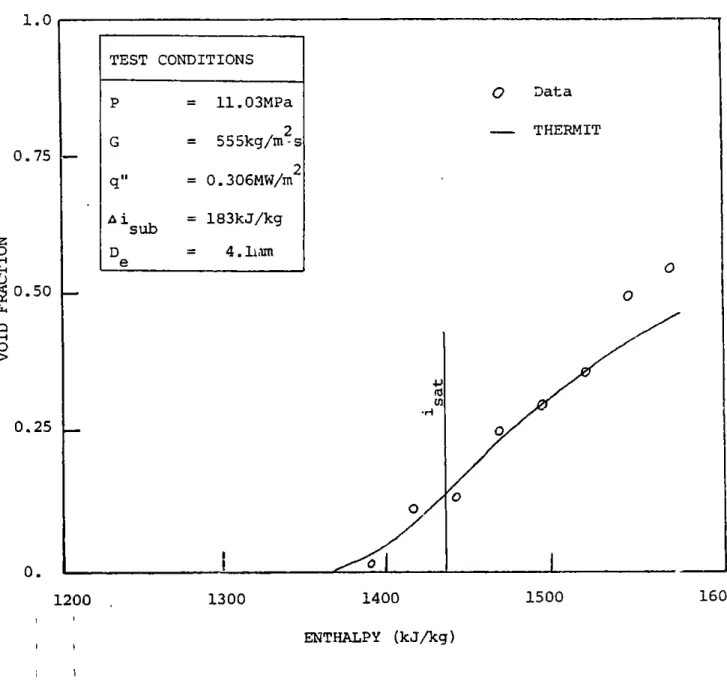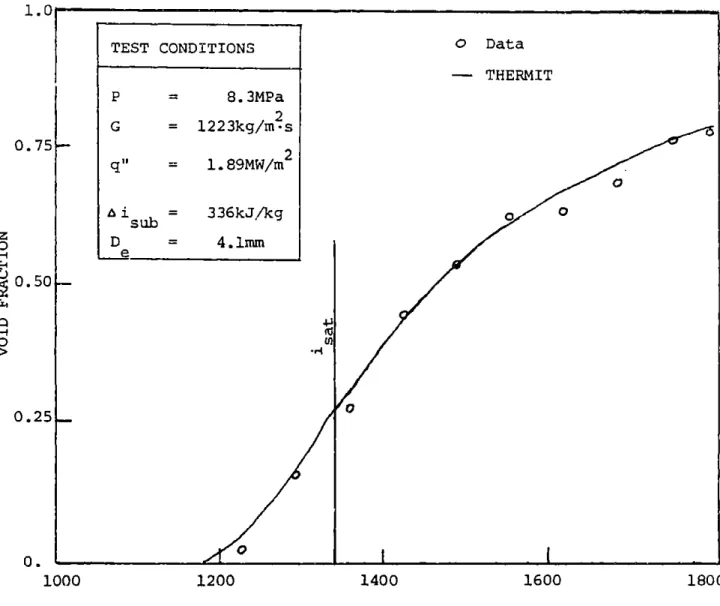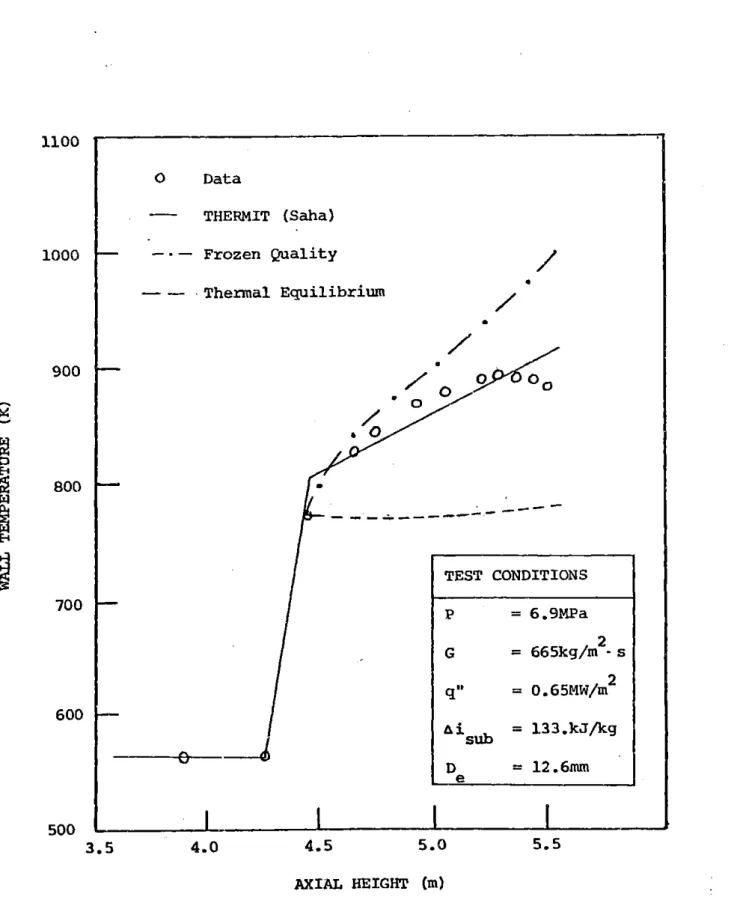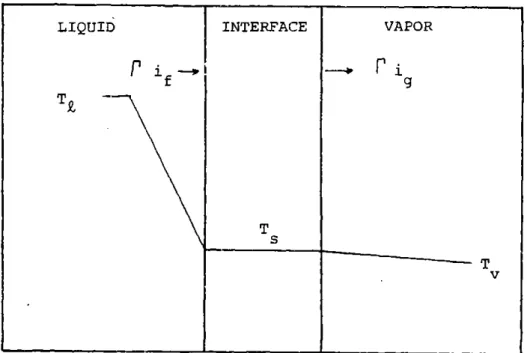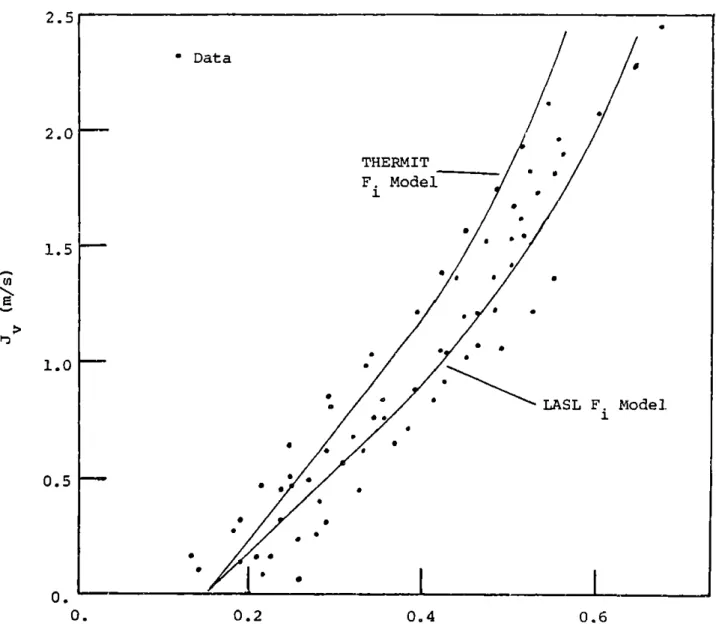FOR
LIGHT WATER REACTOR SUBCHANNEL ANALYSIS
by
JOHN EDWARD KELLY
B.S.N.E.,
University of Michigan, (1976} S.H., Massachusetts Institute of Technology, (1978)SUBMITTED
INPARTIAL FULFILLMENT OF THE
REQUIREMENTS FOR THE
DEGREE OF
DOCTOR
OF PHILOSOPHY
at the
MASSACHUSETTS INSTITUTE OF TECHNOLOGY
AUGUST1980
@
Massachusetts Institute of Technology1980
Signatur.e of Author -
~~~nat~-~e
... _9_<1~8LIIIIC.,..te_d
______
_
Depart~t of Nuclear Engi~ng, August 8, 1980Signature redacted
Certified by ,,,- ""' ---o~---0--#---T-h_e_s_i_s_S--up-e-.r-v_i_s_o_rSignature redacted
Accepted by _ _ _ C_h_a_i_rm_a_n-,-b--D-e-~_..~-rt--~-e-rn-;-C-;nnn---g-t-t-.e-e_o_n_G_r_a_d_u_a_t_e_S_t_u_d~e-n_t_sIRcHtV((J
rt-""'"'A "' "· •Mu.)o~~T~~~1J&gi51;;u~
NOV
3
19SO
1.IBRARIES
DEVELOPMENT OF A TWO-FLUID, TWO-PHASE MODEL
FOR LIGHT WATER REACTOR SUBCHANNEL ANALYSIS
by
John Edward Kelly
Submitted to the Department of Nuclear Engineering on August 8, 1980 in partial fulfillment of the requirements for the Degree of Doctor of Philosophy in
Nuclear Engineering
ABSTRACT
The-problem of developing and assessing the two-fluid model computer code THERMIT for light water reactor (LWR) subchannel analysis
has been addressed. The developmental effort required a reformulation
of the coolant-to-fuel rod coupling so that THERMIT is now capable of
traditional coolant-centered subchannel analysis. A model that accounts
for mass, momentum and energy transport between mesh cells due to
turbulent mixing for two-phase conditions has also been introduced. This model is the first such attempt in a two-fluid context.
The liquid-vapor interfacial exchange terms in the two-fluid model have been modified for improved accuracy. A systematic evaluation
of the exchange models has been performed. The mass and momentum exchange rates between the vapor and the liquid for pre-CHF conditions were
evaluated by comparison to void fraction data in over 30 one-dimensional
steady-state experiments reported in the open literature. The
liquid-vapor energy exchange rate for post-CHF conditions was assessed using 15 steady-state, one-dimensional wall temperature measurements also found in the open literature. The two-phase mixing model has been evaluated using
G.E. and Ispra BWR and PWR rod-bundle measurements. Comparisons with these measurements have shown the appropriateness of this model. The assessment of the wall-to-coolant heat transfer model used steady-state, one-dimensional as well as transient, three-dimensional measurements. The comparisons resulted in a modification of the Biasi CHF correlation
to imptove 'its predictions.
THERMIT has been shown to accurately predict the thermal-hydraulic behavior of rod-bundles. Thus, it represents the first two-fluid computer code with this proven capability.
Thesis Supervisor: Mujid S. Kazimi
Title: Associate Professor of Nuclear Engineering
Thesis Reader: John E. Meyer..
ACKNOWLEDGEMENTS
The author would like to express his sincere gratitude to all those who assisted him in the preparation of this thesis. In particular, special recognition is given to the following individuals.
To Professor Mujid Kazimi who, as my thesis advisor has generously given his time and advice. His valuable comments and suggestions have
greatly contributed to this thesis.
To Professor John Meyer who, as my thesis reader, has been very helpful during the course of this work.
To Professor Lothar Wolf, whose encouragement and advice have been greatly appreciated.
To Don Dube and Andrei Schor, who have shared with me many instructive discussions concerning THERMIT.
To Ping Kao, Samir Mohammed, Jim Loomis and Mahmoud Massoud who have assisted me in the computer related activities.
To Gail Jacobson and Riva Esformes who have typed this thesis.
To my wife, Sue, and all of my family whose constant encouragement and support have led to the successful completion of this work.
Finally, the financial support of Boston Edison Company, Consumers Power Company,.Northeast Utilities Service Company, Public Service
Electric and Gas.Company, and Yankee Atomic Electric Company under the sponsorhsip of the M.I.T. Energy Laboratory is greatly appreciated.
TABLE OF CONTENTS Section ABSTRACT ACKNOWLEDGEMENT S TABLE OF CONTENTS LIST OF FIGURES LIST OF TABLES NOMENCLATURE CHAPTER 1 - INTRODUCTION 1.1 Background 1.2 Research Objective 1.3 Development Approach
CHAPTER 2 - REVIEW OF PREVIOUS WORK
2.1 Introduction
2.2 Rod Bundle Analysis Techniques
2.2.1 Subchannel Analysis
2.2.2 Distributed Resistance Models
2.3 Two-Phase Flow Models
2.4 Description of THERMIT
2.4.1 Background
2.4.2 General Characteristics
2.4.3 Two-Fluid Model Conservation Equations 2.4.4 Finite Difference Equations
2.4.5 Constitutive Equations
CHAPTER 3 - DEVELOPMENT OF THERMIT SUBCHANNEL ANALYSIS
CAPABILITY 3.1 Introduction Page 2 3 4 7 12 14 17 17 19 21 23 23 29 29 32 33 35 35 35 38 40 49 52 52
Section
3.2 Geometrical Modeling Capability
3.3 Two-Phase Turbulent Mixing Model
3.3.1 Background
3.3.2 Model Formulation 3.3.2.1 Background
3.3.2.2 Analytical Formulation and
Discussion
3.3.2.3 Numerical Scheme
CHAPTER 4 - DEVELOPMENT AND ASSESSMENT OF THE
LIQUID-VAPOR INTERFACIAL EXCHANGE MODELS 4.1 Introduction
4.2 Assessment Strategy
4.3 Interfacial Mass Exchange
4.3.1 Background
4.3.2 Subcooled Vapor Generation Model
4.3.3 Droplet Vaporization Model
4.4 Interfacial Energy Exchange
4.5 Interfacial Momentum Exchange
CHAPTER 5 - ASSESSMENT OF THE TWO-PHASE MIXING MODEL
5.1 Introduction
5.2 G.E. 9 Rod Bundle Tests
5.2.1 Test Description
5.2.2 Single-Phase Comparisons 5.2.3 Uniformly-Heated Cases
5.2.4 Evaluation of Mixing Parameters
5.2.5 Non-Uniformly Heated Cases
Page 53 56 56 60 60 62 69 71 71 72 75 75 80 94 105 114 138 138 145 145 150 152 156 161
Section
5.3 Ispra BWR Tests
5.3.1 Test Description 3.3.2 Results
5.4 Ispra 16 Rod PWR Cases 5.4.1 Test Description 5.4.2 Results
5.5 Conclusions
CHAPTER 6 - THE HEAT TRANSFER MODEL
6.1 6.2 6.3 CHAPTER 7.1 Introduction Modifications Assessment 6.3.1 Steady-State Results 6.3.2 Transient Results
7 - CONCLUSIONS AND RECOMMENDATIONS
Conclusions
7. 2 Recommendations
REFERENCES
APPENDIX A DERIVATION APPENDIX B TWO-PHASE M
APPENDIX C HEAT TRANSFI
OF THERMIT GOVERNING EQUATIONS IXING MODEL ASSESSMENT RESULTS
ER CORRELATIONS 163 163 167 175 175 177 186 188 188 194 199 200 217 232 232 239 242 247 267 280
LIST OF FIGURES Figure 2.1 2.2 2.3 3.1 4.1 4.2 4.3 4.4 4.5 214-9-3
Fraction versus Enthalpy for Maurer 214-3-5
Fraction versus Enthalpy for Marchaterre
168
Fraction versus Enthalpy for Marchaterre 184
Temperature Comparisons for Bennett
5332
Temperature Comparisons for Bennett
5253
Temperature Comparisons for Bennett Case 4.6 Void Case 4.7 Void Case 4.8 Void Case 4.9 Wall Case 4.10 Wall Case 4.11 Wall Case 5442
4.12 Comparison of Wall Temperature Predictions Using Various r Models for Bennett Case 5332 4.13 Temperature Distributions for Subcooled Boiling
and Droplet Vaporization
Page 31 42 48 57 77 79 82 83
Coolant-Centered and Rod-Centered Layouts Typical Fluid Mesh Cell Showing Locations of Variables and Subscripting Conventions Typical Rod Arrangement in Transverse Plane
Illustration of Fuel Rod Modeling
Boiling Regimes in Two-Phase Flow in a Vertical Ttbe with Heat Addition
Illustration of Vapor Generation Rate, F, versus Equilibrium Quality, X
Illustration of Vapor Bubble Nucleation and Growth
Typical Temperature Distributions in Subcooled Boiling
Void Fraction versus Enthalpy for Maurer
101 102 103 104 107 90 91 92 93
Figure Page
4.14 Predicted Liquid and Vapor Temperatures for l11
Maurer Case 214-3-5
4.15 Predicted Liquid and Vapor Temperatrues for 112
Bennett Case 5336
4.16 Typical Flow Patterns in Two-Phase Flow 115
4.17 Void Fraction versus Enthalpy for Maurer 129
Case 214-3-4
4.18 Void Fraction verius Enthalpy for Christensen 130
Case 12
4.19 Void Fraction versus Enthalpy for Christensen 131
Case 9
4.20 Void Fraction versus Enthalpy for Marchaterre 132
Case 185
4.21 Void Fraction versus Enthalpy for Christensen 134
Case 12
4.22 Comparison of Predicted Slip Ratios for 135
Christensen Case 12
4.23 Vapor Superficial Velocity versus Void Fraction 137
for Christensen Data
5.1 Cross Sectional View of G.E. 9 Rod Bundle Used 146
in Mass Velocity and Enthalpy Measurements
5.2 Radial Peaking Factors for Non-Uniformly Heated 148
Cases
5.3 Comparison of Measured and Predicted Mass 151
Velocities for G.E. Isothermal Tests
5.4 Comparison of Measured and Predicted Exit Quality 153
in Corner Subchannel for G.E. Uniformly Heated
Cases
5.5 Comparison of Measured and Predicted Exit Quality 154
in Edge Subchannel for G.E. Uniformly Heated
Cases
5.6 Comparison of Measured and Predicted Exit Quality 155
in Center Subchannel for G.E. Uniformly Heated Cases
Figure
5.7 Comparison of Measured and Predicted Mass Velocities for G.E. Uniformly Heated Tests
5.8 Comparison of G.E. 2E Cases with 6M Varied
from I to 10
5.9 Comparison of THERMIT Predictions for Case 2E2 with Variations in KM
5.10 Comparison of Measured arid Predicted Quality for G.E. Non-Uniformly Heated Tests
5.11 Comparison of Measured and Predicted Mass Velocities for G.E. Non-Uniformly Heated Tests
5.12 Cross Sectional View of Ispra BWR Test Section
5.13 Comparison of Measured and Predicted Exit Quality
in Subchannel 2 - Ispra BWR Tests
5.14 Comparison of Measured and Subchannel I versus Bundle Ispra BWR Tests
5.15 Comparison of Measured and Subchannel 5 versus Bundle Ispra BWR Tests
5.16 Comparison of Measured and Subchannel 4 versus Bundle Ispra BWR Tests
5.17 Comparison of Measured and Velocities for Subchannels
BWR Tests
Predicted Quality for
Average Quality
-Predicted Quality for
Average Quality
-Predicted Quality for
Average Quality
-Predicted Mass 1 and 2 - Ispra
5.18 Comparison of Measured and Predicted Mass Velocities for Subchannel 4 and 5 - Ispra
BWR Tests
5.19 Cross Sectional View of Ispra PWR Test Section 5.20 Comparison of Measured and Predicted Exit
Quality for Subchannel 1 versus Bundle Average Quality - Ispra PWR Tests
5.21 Comparison of Measured and Predicted Exit Quality for Subchannel 2 versus Bundle Average Quality - Ispra PWR Tests
Page 157 159 160 162 164 165 169 170 171 172 173 173 176 179 180
Figure Page
5.22 Comparison of Measured and Predicted Exit 181
Quality for Subchannel 3 versus Bundle Average Quality - Ispra PWR Tests
5.23 Comparison of Measured and Predicted Exit 182
Quality for Subchannel 4 versus Bundle Average Quality - Ispra PWR Tests
5.24 Comparison of Measured and Predicted Exit 183
Quality for Subchannel 5 versus Bundle
Average Quality - Ispra PWR Tests
5.25 Comparison of Measured and Predicted Mass 184
Velocities for Ispra PWR Tests
5.26 Comparison of Measured and Predicted Mass 185
Velocities for Ispra PWR Tests
6.1 Typical Boiling Curve 189
6.2 BEEST Heat Transfer Logic 193
6.3 Modified Heat Transfer Logic 198
6.4 Typical Wall Temperature Distribution for 201
Bennett Case 5273
6.5 Comparison of Measured and Predicted Pre-CHF 203
Wall Temperatures for Bennett Case 5332
6.6 Comparison of Measured and Predicted Pre-CHF 204
Wall Temperatures for Bennett Case 5276
6.7 Comparison of Measured and Predicted Pre-CHF 205
Wall Temperatures for Bennett Case 5253
6.8 Comparison of Measured and Predicted Pre-CHF 206
Wall Temperatures for Bennett Case 5394
6.9 Comparison of Measured and Predicted Pre-CHF 207
Wall Temperatures for Bennett Case 5451
6.10 Illustration of Mass Velocity and Quality 213
Dependence of Biasi CHF Correlation
6.11 Cross Sectional View of G.E. 9 Rod Bundle Used 219
in Transient CHF Tests
6.12 Comparison of MCHFR Predictions versus Time for 221
Figure Page
6.13 Comparison of MCRFR Predictions versus 222
Time for Case 9-170
6.14 Comparison of MCEFR Predictions versus 223
Time for Case 9-175
6.15 Comparison of MCHFR Predictions versus 224
Time for Case 9-179
6.16 Comparison of Biasi Correlation Predictions 226
for Case 9-151 with Modified Grid Coefficients
6.17 Comparison of Biasi Correlation Predictions with 228
a Tighter Convergence Criterion (Case 9-179)
6.18 Comparison of Measured and Predicted Maximum 229
Wall Temperatures for Case 9-179
6.19 Comparison of Measured and Predicted Maximum 231
Wall Temperatures for Case 9-151
A.1 Illustration of Control Volume Containing 252
LIST OF TABLES
Tableage
2.1 Features of Some Thermal-Hydraulic Computer Codes 24
2.2 Thermal-Hydraulic Code Classification Criteria 25
2.3 Summary of Two-Phase Flow Models 27
2.4 Summary of Transport Processes 50
3.1 Implicit Heat Transfer Algorithm 55
4.1 Summary of Assessment P.rogram 74
4.2 Test Conditions for One-Dimensional Steady-State 89
Data
4.3 Test Conditions used to Develop Saha Correlation 97
for Post-CHF
4.4 Bennett Test Conditons for CHF in Tubes 100
4.5 Summary of Liquid-Vapor Intezfaciai Forces 121
4.6 Comparison of Viscous Force Coefficients 124
4.7 Comparison of Inertial Force Coefficients 126
5.1 Test Conditions for Rod-Bundle Experiments 143
6.1 Summary of Heat Transfer Correlations 192
6.2 CHF Comparisons for Bennett Test Cases 211
6.3 CHF Comparisons for Bennett Test Cases with 216
Corrected Biasi Correlation
6.4 Summary of Transient CHF Cases 218
7.1 Summary of Modifications and Improvements Made 233
in THERMIT
A.1 Summary of Terms Used in Conservation Equations 250
B.1 Test Conditions for- Rod-Bundle Experiments 268
B.2 Comparison of Measured and Predicted Exit Mass 269
Velocities for Isothermal Tests in 9 Rod G.E. Tests
B.3 Comparison of Measured and Predicted Exit Quality Distributions for Uniformly Heated 9-Rod G.E. Cases B.4 Comparison of Mass Velocity Heated Cases B.5 Comparison of Mass Velocity BWR Cases
Measured and Predicted Quality and Distributions for G.E. Non-Uniformly
Measured and Predicted Quality and Distributions for Ispra 16-Rod
c0.1 Heat Transfer Correlations
270
274
276
A Area Cd Drag Coefficient C Specific Heat D Diameter e Internal Energy F Gravitational Force
F Vapor-Liquid Interfacial Momentum Exchange Rate
Ft Turbulent Momentum Exchange Rate
F Wall Frictional Force
g Gravitational Constant
G Mass Flux
H Heat Transfer Coefficient
i Enthalpy
J v Superficial Vapor Velocity
k Thermal Conductivity
K Mixing Model Parameter
M
L Length
P Pressure
Pr Prandtl Number
Qi
Interfacial Heat Transfer RateQt Turbulent Heat Transfer Rate
QW Wall Heat Transfer Rate
i Power
q"I Heat Flux R b Bubble Radius
Nomenclature (continued)
Re Reynolds Number
S Slip Ratio (V /V
S ij Gap Spacing Between Coolant Channels
t Time
T Temperature
Td Bubble Departure Temperature
V Velocity
VR Relative Velocity (Vv - V)
W Volume
W' Turbulent Mixing Rate
WI" Turbulent Mass Flux t
W t Mass Exchange Due to Turbulence
X Quality
a Void Fraction
a Surface Tension
Parameter Defined in Eq. (3.33)
r Vapor Generation Rate
p Density
11 Viscosity
0 Mixing Model Parameter
E/ Turbulent Velocity
Generalized Mixing Rate Term
T Turbulent Shear Force
Subscripts i,j,k f g s v w Nodal Locations Saturated Liquid Saturated Vapor Liquid Saturation Vapor Wall Superscripts
x,y,z Spatial Directions
Anticipated Transient Without Scram Boiling Water Reactor
Critical Heat Flux
Critical Heat Flux Ratio Critical Power Ratio
Departure from Nucleate Boiling Loss of Coolant Accident
Light Water Reactor
Minimum Stable Film Boiling Pressurized Water Reactor Acronyms_ ATWS BWR CHF CHFR CPR DNB LOCA LWR MSFB PWR
1.0 INTRODUCTION
1.1 Background
Light water reactor safety research is ultimately aimed at ensuring that the public will not be adversely affected if any of a variety of
anticipated or postulated reactor accidents should occur. This
require-ment is met by specifying operational design limits that are based on
conservative assumptions for the behavior of the reactor. Reactor safety
research is primarily concerned with validating the appropriateness of these limits as well as assessing the margins- present in these limits.
In order to study the normal and abnormal transient behavior of nuclear reactors, many complex-phenomena and systems need to be analyzed. One of the major areas which must be investigated.:is the thermal-hydraulics of the reactor system. Included here are the reactor core heat removal
system, the secondary heat removal system (if present) as well as any
auxillary systems which are related to removal of heat from the reactor. Since most of the radioactive inventory is contained within the reactor
core, the preservation of the core integrity is essential. Moreove;,.the most likely radioactivity release mechanisms result from a thermally
induced failure of the fuel rod cladding. Thus, the thermal-hydraulic behavior of the core is generally the most important consideration of
reactor safety analysis.
In order to meet the objective of accurately predicting the thermal-hydraulic field in the reactor core a number of analytical tools have
been developed. These range from simple one equation models, used to predict a particular phenomenon, to large computer codes which attempt
to analyze the entire reactor system. Typically, the most widely used and generally the most useful tools are the thermal-hydraulic computer codes. Simply stated, these codes attempt to numerically solve the mass, momentum and energy conservation equations for a particular geometrical
configuration and for the conditions of interest. Since the conservation
equations must be supplemented by empirical correlations needed to describe specific phenomena, the thermal-hydraulic computer codes are engineering analysis tools which combine basic physics with empirical models.
In the past few years, the need for improved analysis of nuclear reactor safety has lead to the rapid development of advanced methods for
multidimensional thermal-hydraulic analysis. These methods have become
progressively more complex in order to account for the many physical phenomena which are anticipated during both steady-state and transient
conditions. In particular, the modeling of two-phase flow, which is
required for both BWR and PWR systems, is especially complex. In two-phase flows, both thermal and mechanical non-equilibrium between the two phases can exist. These non-equilibrium effects take the form of sub-cooled boiling, vapor superheating and relative motion of the two phases. In order to have realistic calculations, these physical phenomena must be accounted for in the numerical method.
The numerical methods must also be capable of analyzing the many
flow patterns which occur in postulated transients. For example, in a
loss of coolant accident (LOCA) or a severe anticipated transient without scram (ATWS), flow reversal or counter-current flow may occur in the
reactor core. Elaborate solution techniques have been developed specifi-cally to be able to describe fluid fields with no restriction on speed or direction.
cable for all transients, it is necessary that a code be able to analyze all anticipated flow conditions in problems for which the code is applied.
The only practical way to realize the needed flexibility is to combine
realistic physical models with unrestricitive numerical solution
techniques. Hence, the trend in current thermal-hydraulic safety research
is to pursue the development of such codes.
1.2 Research Objective
As discussed in the previous section, the thermal-hydraulic computer codes play a key role in LWR safety analysis. However, due to the limita-tions of present day computers, precise details of the thermal-hydraulic behavior can only be determined for a relatively small region of the
core. The response of the entire reactor can be determined if large
control volumes are used. However, within these volumes information
about the temperature and flow distribution is lost. If these distribu-tions are important for assessing the safety of the reactor, then detailed modeling is required. By using smaller control volumes, for example
sub-channels, sufficient temperature and flow information can be determined, but only for limited regions of the core. For instance, the largest
region which might be analyzed on a subchannel basis would be one BWR
8 x 8 assembly. Nevertheless, if the limiting region of the core can be identified, then this type of detailed analysis is sufficient to
evaluate the safety of the reactor.
A number of power and flow transients do require detailed subchannel
previous computer codes, which have used subchannel modeling, have either
lacked a realistic two-phase flow model (e.g. COBRA IV [1]) or lacked an
unrestricted solution technique (e.g. COBRA-IIIC [2]). Consequently, the
applicability of the previous codes is somewhat limited.
In view of the shortcomings of the previous codes, a new code which does not suffer from these deficiencies has been developed. Using the computer code THERMIT [31 as a framework, the present developmental effort has expanded the capabilities of THERMIT such that the new version of THERMIT can successfully analyze subchannel geometry [4].
THERMIT has been selected for this project due to its two-phase flow model and solution technique. The two-fluid, two-phase model which is used in THERMIT realistically allows for thermal and mechanical non-equilibrium between the phases. This feature permits description of the
complex phenomena encountered during transients. The solution technique
is a modification of the ICE method [5,6], and is capable of predicting
the flow conditions with minimum restrictions.
The primary application of this new version is transient analysis of
LWR rod bundles on a subchannel basis. Although depressurization
tran-sients (i.e. LOCA) have not been excluded as possible applications of this code, these transients are not the primary type of transient under
consid-eration. Rather, anticipated or near-operational power and flow transients
are the main focus of the present development considerations. By
concen-trating on non-depressurization transients, the code can be validated for
several practical conditions. Furthermore, the proper analysis of a LOCA
generally requires modeling the entire reactor system and THERMIT has been designed for core analysis only. Consequently, the applications for this new tool are limited to cases which can be analyzed by modeling only the
core and supplying appropriate core flow boundary conditions. Neverthe-less, these cases represent a large number of problems with practical interest.
With the ability to analyze subchannels, THERMIT is the first two-fluid model code with this capability. Due to the advanced treatment of the two-phase flow and reliable solution method, this code represents a significant addition to the area of rod-bundle thermal-hydraulic analysis. Other multi-fluid codes that may be used for subchannel applications are still under development at Argonne National Laboratory (COMMIX-2 (7-1) and Battle Pacific Northwest Laboratory (COBRA-TF [8]).
1.3 Development Approach
The development of this new version of THERMIT has been accomplished using the following strategy:
(1) Modify the code structure and numerical method as necessary,
(2) Verify, extend, and assess the constitutive models,
(3) Assess numerical properties of the code, and
(4) Implement improved models as necessary.
This strategy is actually iterative in nature. That is, as the need for improved models is found, code modifications and assessment are subsequent-ly required. Hence, the above steps overlap one another.
This development can be divided into two main steps. The first step
has involved modifying the original version of THERMIT so that subchannel geometry could be analyzed. This modification has affected both the geo-metrical modeling capability as well as the physical modeling. The
geo-metrical modeling changes were required so that the traditional
physical modeling wer necessary to account for turbulence effects in
single phase and two-phase flows for rod-bundle analysis. After reviewing
previous work in Chapter 2, the significant work related to this modifica-tion effort is discussed in Chapter 3.
After implementing the capability for subchannel analysis, the second
step has been the validation and assessment of the code. A strategy has
been adopted which allows for independent assessment of the various
con-stitutive models using open literature experimental measurements.
Measure-ments typical of expected subchannel conditions have been compared with the code's predictions in this effort. These comparisons are useful for both validating the predictive capability of the code as well as identi-fying areas which require improvement. The net result of this assessment effort is that the code can be used with confidence for subchannel appli-cations. The results of this assessment are discussed in Chapters 4, 5
and 6.
A listing of the actual computer code will not be given here due to
its length. Rather, the interested reader is referred to reference 9 which contains detailed information on the usage of this new version of THERMIT. Sample problems as well as input instructions are given in this
2.0 REVIEW OF PREVIOUS WORK
2.1 Introduction
Nuclear reactor thermal-hydraulic safety research encompasses both
experimental and analytical investigations. The experimental research
attempts to measure and identify the important variables in both
single-phase and two-single-phase flows. The analytical research attempts to develop
methods which numerically solve the equations describing the heat transfer and fluid dynamics in a reactor. Elabocate numerical methods have evolved which rely heavily on the use of digital computers. Conceivably, if all of the significant physical phenomena are considered in the computer code, then accurate predictions of the flow conditions can be obtained. These-methods can also analyze conditions which could not be directly measured. The only practical limitation of these methods is the problem
size which a computer can accomodate in terms of both storage and execution times.
Since this thesis has been concerned with the development of the
thermal-hydraulic computer code, THERMIT, it is instructive to review the
general characteristics of nuclear reactor thermal-hydraulic codes. The
key features of a few of these codes are presented in Table 2.1. As
discussed by Massoud [13j, it is possible to classify the codes according
to the criteria summarized in Table 2.2. The first major division is re-lated to the code's capability to handle one component or the entire by-draulic loop. Loop codes analyze a number of components simultaneously and,
Features of Some Thermal-Hydraulic Computer Codes
Computer Type of Method of Two-Phase Solution Technique
Code Analysis Analysis Flow Model
COBRA IIIC [2] Component Subchannel Homogeneous Equilibrium Marching Method
COBRA IV [1] Component Subchannel Homogeneous Equilibrium Marching Method or
I.C.E. Method
WOSUB [10] Component Subchannel Drift Flux Marching Method
COMMIX-2 [7] Component Distributed Two-Fluid I.C.E. Method
Resistance
THERMIT [3] Component Distributed Two-Fluid I.C.E. Method
Resistance
TRAC [12] Loop Distributed Two-Fluid or Drift Flux I.C.E. Method
Resistance
TABLE 2.2
Thermal-Hydraulic Code Classification Criteria
1. System Analysis Capability
A. Loop Codes
B. Component Codes
i. Subchannel Analysis
ii. Distributed Resistance Analysis
iii. Distributed Parameter Analysis
2. Two-Phase Flow Model
A. Homogeneous Equilibrium Model
B. Drift-Flux Model
consequently, analysis is not as detailed as found in the individual com-ponent codes. However, the component codes must have appropriate boundary
conditions supplied from external calculations. This prevents accurate
modeling of the coupling between the component and the rest of the system. Naturally, loop codes do not suffer from this problem.
Component codes, specifically those intended for rod-bundle analysis, can be further classified according to their analysis method. This
topic has been reviewed by Sha [14]. Three types of methods can be
identified; subchannel analysis, distributed resistance analysis and
dis-tributed parameter analysis. Each of these analytical techniques has
certain advantages and disadvantages relative to the other methods.
Sub-channel analysis techniques permit fairly detailed analysis of the flow,
but are limited by inherent assumptions concerning the flow. Distributed
resistance methods can analyze either large or small regions but require
the accurate determination of the flow resistances. The distributed
parameter analysis method gives the most detail of the flow structure, but is limited to small regions. All gf the core component codes use
one of these three analysis techniques.
The second major division is the type of two-phase flow model. The
important types of models which have been incorporated into
thermal-hydraulic codes include the homogeneous equilibrium model (HEM), the drift-flux model, and the two-fluid model. Essentially, the type of
two-phase model refers to the number of conservation equations which are
used to describe the two-phase flow, as summarized in Table 2.3. As the
number of conservation equations increases, the number of constitutive
models also increases. However, with more equations, accurate results are more likely to be predicted for severe conditions. The more general
Summary of Two-Phase Flow Models [151
Two-Phase Conservation Equations Constitutive Laws Imposed Restrictions On:
Flow Model
Mass Energy Momentum F
Q
r
Q
Fi Phasic Phasic PhaticW W Temperatures Velocities Distributions
Homogeneous 1 1 1 1 1 0 0 0 Equal Equal Uniform
Drift Flux 2 1 1 1 1 1 0 0 T -T Slip None
Relahion Relation
4 Equation 1 2 1 1 2 0 1 0 None Slip Uniform
Relation
Models 1 1 2 2 1 0 0 1 T -T2 None Uniform
Relation
Drift Flux 2 2 1 1 211 1 0 None Slip None
Relation
5 Equation 2 1 2 2 1 1 0 1 T -TR None None
Relation
Models 1 2 2 2 2 0 111 None None Uniform
Two-Phase Conservation Equations Constitutive Laws Imposed Restrictions On:
Flow Model
Mass Energy Momentum F 1 P Q F Phasic Phasic Phasic
Temperatures Velocities Distributions
Two-Fluid 2 2 2 2 2 1 1 1 None None None
Three-Fluid 3 3 3 3 3 2 2 2 None None None
(Liquid,
Vapor and
Liquid Drops)
equations also allow better physical modeling which is essential for the description of two-phase flow.
Since the present work is concerned with the application of the two-fluid model code THERMIT to detailed rod-bundle analysis, it is useful to discuss in detail both the type of analysis techniques and the two-phase
flow models. The analysis techniques are discussed in Section 2.2 while
the two-phase flow models are discussed in Section 2.3. Following this
discussion, the specifics of the THERMIT computer code will be given in
Section 2.4.
2.2 Rod-Bundle Analysis Techniques
As discussed in the previous section, three types of techniques are
available for rod-bundle analysis. These include subchannel analysis,
distributed resistance analysis and distributed parameter analysis. The
distributed parameter methods are limited to very small regions and will not be discussed here. The other two methods, however, are very useful for analyzing the entire rod-bundle and are discussed in detail.
2.2.2 Subchannel Analysis
Of all the methods developed for analyzing the thermal-hydraulic
behavior in complex rod-bundle geometry, the subchannel method has been found to be particularly well-suited. Weisman and Bowring [16] and
Rouhani (17] have reviewed this type of analysis and present the following
view of traditional subchannel analysis.
In this method, the rod-bundle cross section is subdivided into a number of parallel interacting flow subchannels. Conventionally these subchannels are defined by lines joining the fuel rod center (see Figure
2.la). This choice is somewhat arbitrary and other choices are possible,
such as the lines of zero shear stress (see figure 2.lb) [12]. This latter type of subchannel is referred to as a rod centered subchannel while the former type is called a coolant centered subchannel.
Once the radial plane has been defined, each subchannel is divided axially into a number of intervals (nodes) which are typically between
8 and 30 cm long. For each node, which can be thought of as a control volume, a set of mass, energy, axial momentum and transverse momentum conservation equations are written and solved with an iterative technique.
The main assumptions of this method are:
(1) The detailed velocity and temperature destributions within
a subchannel are ignored;
(2) The transverse nomentum equation is simplified due to the
assumption of predominantly axial flow.
The first assumption reflects the fact that only spatially averaged
parameters are contained in the conservation equations. Consequently,
the distributions within the control volume can not be calculated. The second assumption means that, due to the predominance of the axial flow, the transverse momentum exchange can be crudely represented without
introducing significant errors. Hence, the transverse momentum equation
is usuallr much simpler than the axial momentum equation.
A number of- computer codes have been developed which use the
sub-channel analysis method. Among these are included COBRA IIIC [2], COBRA-IV [1] and WOSUB (10]. These codes treat most of the
important phenomena in the same way and in each code a marching type
solution method is utilized. (COBRA-IV also contains a modified I.C.E. method [19] for transient analysis.) The marching method begins the
- I
-Figure 2.1b: Rod-Centered Subchannel Layout
.IMF-- nowalm--- Immmwmr
calculation of the flow parameters at the core inlet and moves upward,
in a stepwise manner, simultaneously solving the conservation equations for all subchannels, at each axial level. Typically, more than one sweep through the core will be required to obtain a converged solution.
Therefore, the marching method is basically an iterative technique.
For steady-state, single-phase conditions, the subchannel codes can generally predict the correct flow distributions in rod-bundles [16]. However, for two-phase conditions or severe transients, the use of the subchannel codes may not be strictly valid. For example, comparisons of COBRA-IIIC with steady-state two-phase flow measurements have indicated that the correct flow and enthalpy distributions could not be calculated
[10]. Also, if a strong perturbation causes large lateral flow, then the basic assumption in these codes is violated. Furthermore, if reverse flow should occur, then the marchiAg type solution method will fail
un-less appropriately modified. Consequently, although useful for many
rod-bundle problems, the subchannel codes are limited in their applica-tions.
2.2.2 Distributed Resistance Models
In order to eliminate the assumptions and restrictions of the
sub-channel methods, distributed resistance models have been developed. These
models also referred to as porous body models, use orthogonal coordinates and geometrically similar control volumes. The name for this method is
due to the fact that frictional resistances are distributed throughout
each of the control volumes. Quasi-continuum governing equations are
written for the conservation of mass, energy or momentum and no
no restrictions are placed on the flow conditions. However, as in the case of subchannel analysis, the details of the flow structure within a control volume cannot be determined.
By employing Cartesian coordinates, the geometrical noding of the
rod-bundle can be the same as for subchannel analysis (i.e., for square
bundles). Hence, the information obtained by the distributed resistance
method is at least as detailed as that found in subchannel methods. Of
course, the governing equations in the distributed resistance methods are more general than those in subchannel analysis methods.
However, the key to successful use of this method is the correct formulation of expressions for the transport processes in the control
volume (i.e., heat transfer, friction, etc.). These processes can be
described for most conditions, but completely general formulations are
noc possible. However, these processes can usually be defined for many
cases of practical interest.
A number of computer codes use the distributed resistance method.
Among these are COMMIX-1 [11], TRAC [121, and THERMIT [3]. Each of
these codes use some form of the I.C.E. solution technique [6]. This technique coupled to the full three-dimensional representation of the distributed resistance method allows for the calculation of flow reversal, recirculating flow and even counter-current flow in two-phase conditions. With the ability to analyze these conditions, the above codes represent
powerful tools for steady-state and transient thermal-hydraulic analysis
of rod-bundles.
2.3 Two-Phase Flow Models
important feature to be defined is the two-phase flow model. A wide variety of possibilities exist for describing the two-phase flow.
These range from describing the two-phase flow as a pseudo single-phase flow to a multi-component flow (e.g., liquid, vapor and droplets). The various possibilities are summarized in Table 2.3. Generally, as the
two-phase flow model becomes more complex (i.e., more equations), more constitutive equations are required to represent the various interactions between the phases.
The homogeneous equilibrium model (HEM) is the simplest of these models. It assumes that the vapor and liquid are in thermal equilibrium and that there is no relative velocity between the two phases. These assumptions are clearly limiting, but may be adequate for certain flow
conditions. Extensions of this model to include relative velocity (slip)
and thermal non-equilibrium (subcooled boiling) effects are possible using empirical models.
The drift flux models, either the four or five equation models add some complexity to the two-phase flow description. By treating the vapor
and liquid phases as separate streams still in thermal equilibrium, these
methods allow for accurate velocity predictions.
In the two-fluid model, separate conservation equations are written for the vapor and liquid phases. This model allows a very general
des-cription of the two-phase flow. However, it also introduces a large
number of constitutive equations. The most important relations are
those which represent the transfer of mass,
r,
transfer of energy, Qi, and transfer of momentum, F, ,across liquid-vapor interfaces. The advan-tages of using this model is that physically based mechanistic models can be formulated for these terms which should be valid over a wide rangeof conditions.
An extension of the two-fluid model is the three-fluid model in which the three-fluid fields are the vapor, liquid and droplet fields. COBRA-TF
[8
]
is an example of such a model. This formulation, while introducing more constitutive models, seems to contain the necessary capability toanalyze complex flow situations such as the reflood stage of a LOCA.
However, for all but reflood analysis, the two-fluid model is probably
general enough to describe the important non-equilibrium effects.
Con-sequently, THERMIT which uses the two-fluid model, is expected to provide a good description of most two-phase conditions.
The complexity of the two-phase flow model is seen to depend on the
assumptions concerning the non-equilibrium phenomena. Mixture models,
that is either the homogeneous equilibrium or the drift flux models,
contain one or more restrictions on either the thermal or mechanical non-equilibrium in the flow. Only when both phases are represented with separate conservation equations can all the non-equilibrium effects
be modeled.
2.4 Description of THERMIT
2.4.1 Background
It is instructive to review the key characterisitcs of THERMIT prior to the description of the modifications involved in the present work. The characteristics include the conservation equations, finite difference equations and constitutive models.
2.4.2 General Characteristics
at MIT under EPRI sponsorship, solves the three-dimensional, two-fluid equations describing the two-plir;e flow and heat transfer dynamics. This two-fluid model uses separate partial differential equations expressing conservation of mass, momentum, and energy for each individual fluid phase. By using this two-fluid model, thermal and mechanical
non-equilibrium between the phases can exist, only requiring that mathematical expressions for the exchange of mass, momentum and energy be available. Such a formalism allows very general and physically reasonable modeling 'of relative motion of the phases and of thermal non-equilibrium.
A second important feature of the THERMIT fluid dynamics is the
three-dimensional representation of flow is x-y-z geometry. Previous
codes (e.g., COBRA-IIIC) have used a subchannel model which assumes
predominantly axial flow. The rectangular coordinate system in THERMIT
is well-suited for either core-wide or subchannel analyses. THERMIT also
offers the choice of either pressure of velocity boundary conditions
at the top ana botuom of the core. This feature permits realistic modeling of the core boundary conditions and is important for reactor transient
analysis.
A third important feature of THERMIT is the heat transfer modeling. A radial heat conduction model (with gap conductance between the fuel
pellet and cladding) is used with a continuous general boiiing curve describing heat transfer to the fluid both below and above the critical heat flux. The boiling curve is based on recommendations by Bjornard
[20] and consists of five basic regimes: convection to liquid, nucleate
boiling, transition region, stable film boiling, and convection to vapor. The heat flux is modeled as a heat transfer coefficient times a wall-fluid temperature difference in all regimes except in the transition
region, where the heat flux is computed for each phase.
The final important feature of THERMIT is the numerical method used to solve the fluid dynamics equation. A semi-implicit technique is used
which is a modified version of the I.C.E. method [5,6]. As such, the method has a stability restriction in the form of a maximum allowable time step:
At < (Az/Vk min (2.1)
where Az is the mesh and Vk is the larger of the phase velocities. How-ever, the method is not restricted by the direction or speed of the flow. Furthermore, convergence can be obtained at each time step if the
time step is sufficiently small.. Consequently, this numerical method
is ideally suited for severe transient analysis.
Although coarse mesh sizes had originally been envisioned when using THERMIT, there is no intrinsic reason to prohibit the code's
application to small mesh size problems; up to a point. From a numerical
point of view, the solution method does not explicitly restrict the size of the mesh. However, due to stability considerations, a linear mesh size smaller than 0.2 mm may lead to numerical problems [21]. Since this
limit is at least 30 times smaller than subchannel size, no instabilities would be expected for subchannel applications.
Overall.then, it can be stated that THERMIT is a very powerful analytical tool. This code contains an advanced two-phase model and a fairly unrestricted solution.technique. Also since the code is
theor-etically not restricted to large mesh applications, THERMIT would seem
to be well-suited for subchannel applications. However, as will be dis-cussed in Chapter 3, the original version of THERMIT had certain
geo-metrical and physical characteristics which prevented accurate sub-channel analysis. Hence, the code needed to be modified to permit this type of application.
2.4.3 Two-Fluid Model Conservation Equations
The governing equations of the two-fluid model in THERMIT, which are the mass, energy, and momentum conservation equations for each phase, can
be derived from local, instantaneous conservation equations. The general
procedure is to average the equations over time and then average them over an arbitrary volume. The result is a set of time and space averaged
conservation equations which contain a number of integral terms. Examples
of this type of derivation can be found in references 22 and 23.
The THERMIT conservation equations are derived in Appendix A. This derivation begins by applying the appropriate time and space averaging
operators to the local, instantaneous balance equations. The assumptions
required to obtain the THERMIT equations are given and,by suitable
re-arrangement, the appropriate two-fluid model equations are obtained. The major simplifying assumptions are:
(1) that viscous stress and energy dissipation can be
neglected, and
(2) that the liquid and vapor pressures are assumed to be equal within any control volume.
The assumption concerning the viscous and energy dissipation terms is appropriate due to the relatively small value of these terms. The
assumption of uniform pressure is also appropriate provided the size of
the volume is not too large.
set of equations:
Conservation of Vapor Mass
T (pv) + -(pV) = 1-tv
Conservation of Liquid Mass
S[(1-a) p 9]
atk
Conservation-
(p vev)
+
=
Q
+Q-io
Conservat ion + V[(1-a)pv] =-F-
W of Vapor Energy V(ap e V) + P 0-(V + P v v v v at Qtv of Liquid Energy[(l-a)pk] + V-[(1-a)p e V ] + P V.(i-a)o]
aQQ
-
Pa
= Q
- Q
-Qtk
Conservation of Vapor Momentum
V + + + +
ap --- X+czpY
*V
?V+ctVP =- F
- F
v at v v v v wv iv
4. 4+
+
cpvg -
FtvConservation of Liquid Momentum
(+ p+ (1-a) VP = -
-F
+ (1-a g + w -9
+ (1-a)P gz (2. 2a) (2.2b) (2.2c) (2.2d) (2.2e) (2.2f)The notation for these equations can be found in the Nomenclature section.
A few important characteristics of these equations should be discussed.
First, it is seen that all the important transport mechanisms are included. In particular, the terms describing the turbulent transport effects are included in these equations. In the original version of THERMIT, these terms had been neglected. However, for subchannel applications, as well as large fluid plena applications, it is imperative that these terms be included. The turbulent transport terms are discussed in detail in section 3.3.
A second feature of the equations concerns the representation of the
interfacial heat and momentum exchange terms. As written, these terms include the effects of mass transfer between the phases. That is, the interfacial heat transfer term,
Q.,
includes heat conduction between the phases as well as the heat transfer due to mass transfer (e.g.,evap-oration). Similarily, the interfacial momentum exchange term, Fi,
includes the momentum exchange due to mass transfer. In the original version of THERMIT both of these mass transfer effects had been neglected. The absence of the momentum exchange contribution is probably appropriate
due to its relatively small value for most problems. However, the energy
exchange contribution is comparAble with the other terms and, hence, has
now been included in the present formulation. Further details on these
models may be found in Chapter 4.
2.4.4 Finite Difference Equations
The finite difference equations which approximate the above
reference 3. The procedure for obtaining the difference equations is to
approximate the temporal and spatial derivatives by difference operators. Since a semi-implicit differencing method is used, the temporal deriva-tives are replaced by a forward difference operator. The other terms are treated either implicitly or explicitly depending on the term. New
time variables are represented with the superscript n+l while old time variables are superscripted with an n. Source terms are treated as
implicitly.as possible, but do contain some variables evaluated at the old time. Consequently, source terms are superscripted with n+1/2 to indicate their semi-implicit formulation.
The spatial discretization of the equations requires a three-dimen-sional grid to be overlayed on the geometrical configuration under con-sideration. Rice this grid has been defined the locations of the variables
are determined. The convention for associating the variables with a
particular mesh cell is illustrated in Figure 2.2. All unknowns except
the velocities are associated with cell centers. The velocity components
normal to that face are defined. On cell faces, subscripts for the cell-centered quantities are i,
j,
and k, while on cell faces halfincre-ments are used (e.g., 1+1/2, j, k). In order to simplify the following equations, only the half integral subscripts will be retained (e.g.,
Pi+
1/2 refers to P i+1/2,j,k)'With this background information, the finite difference equations
will now be given. In the mass and energy equations control volume flux
balances are used to approximate the divergence terms. With this approxi-mation the equations are:
tV4
k-+ v x Vi. l i,j,kfv
/ / / / / /Vi+
Cell Centered Quantities: P, Tv' T' eV . ' PV' P ' (,
Figure 2.2: Typical Fluid Mesh Cell Showing Locations of
Variables and Subscripting Conventions
/ x i+
Vapor Mass
(ap V)n+ l apV)n 1n x l
v v -+
LA/ PQv(v n+1 1+1/2
At
- [A(ap)"(V) n+i-1/2 + [A(apv)
n n+1
j+1/2
v v j-1/2 + v k+1/2 - [A(ap)nz(Vz
n+1 v v k-1/2j Sn+l/2 n+1/2 tv Liquid Mass ( (1-cx) p dn+1 -(l~cPz) nAt
+1
-[A( (,a) P.) n yn+1 -/2+
-
[A((1--)p )n)n+
11/2
+ -[A((1-a)pz)
n 1n+1] _ _]n+1/2 k-1/2 [A((1-a)p(V)n+ i+/ [A((1-a) p nY) n+1j+1/2 [A((1-a) nVz) n n + 1/ n+1/2 wt 9 Vapor Energy (czp e )n+1v v
n S(czve
+1
[ipn + +/ n1+1/2 At -[Pn
+(pv
-1/2]v[Acn (
+1 i-1/2 + [pn + (pve)?+!2[An( n+ljl, 2 -[
+
J-1/2
(2.3c)
continued(2.3a)
(2.3b)+Pfl + (pev)n I[Acf(VZ)fl+l]I v v +l/2 v k+1/2 (2.3c) concluded - [Pn + (pe1) - 2][Aa?(Vz) n+11
]
+ Pn a+1 -an
n+1/2 n+i/2 _ n+1/2 At WvQtv Liquid Energy ((i-a)pPe2 )n+1_ -((l-a)pke )n (2.3d) At + Pn + (P e ) +1/2][A(l-a)n(Vt) n+1, 1 - [Pn + (p e ) -n/2][A(la)n xn+l -+ [Pn -+ (P e ) +1 1 2][A(l-)n l n+V) +l / - [Pn + (pzet)?-j/2I[A(l-c)n
n+1 j-/]2j-l/2
+ [Pn + (P e )k+n +(pe)k1/22P, 2][A(1-)n zn+lk+k+l/2 - Pn + (P e ) -i2][A(ct)n (Vn+ 1 k-l/2 n(+1
- an n+1/2 n+1/2 n+1/2 - P At )%9JzN
t2.For the momentum equations, the equation for a particular direction is differenced between the centers of the two appropriate cells. Conse-quently, tbe mesh used in the momentum equations is different than that used in the mass and energy equations. Since there are a total of six momentum equations all having the same form, only the z-direction vapor equation will be given. The other equations are found by permutation.
The vapor z-direction momentum equation is given by
(zyn+l
zynz
[(V,)
l -(Vv)
( Pj]
1 2x
( sv)
ap)n v v k+1/2+ a) n xV)Ax v(k+1/2 At + v k+1/2 v k+1/2 Axk+1/2 + (VZV))A zV l v k+1/2 Ay k+1/2 + (V )+/2 z k+l/2 Sk+ k + zk+1/2 Az n+1 /2 n al k~ -Pk~l (Fz )n+l/2 (F
z
)f+l/2
k+
1 2[AZkk+1/2
l=
- (w k+l/2 - iv k+1/2-Qap g)
n(F n
(2.4)
v k+1/2 tv k+1/2.A few important features of these equations need to be highlighted.
First of all, it is seen that values are required for the unknowns at locations other than those defined by the noding convention. For example in the mass equation, the quantity (pv)1+ 1/2 is required. For all such
terms in the mass and energy equations the donor cell logic is used.
Mathematically this can be expressed as
Ci+1 i+1/2 <0
Ci+/
=(2.5)
C i+12 - C if Vi+1/2 >e0
where C is the quantity of interest (i.e., a,
P,
Pv' p etc.).In the momentum equations, no such general rule exists for specifying
variables at locations other than the noding convention. Instead, each
required term is specified separately. The expression for (cPv)k+1/2 is given by
where Ck+l AZk+ + (AZk 'k+1/2 =AZk+ + AZk(2.7) and (pv k+l AZk+l + v AZk (2.8) v k+1/2 - AZk+1 + AZk
Every velocity except (V Z)k+1/2 needs to be difined since they are not at the- aprior defined location. These velocities are defined by:
k+1/2 j-1/2 + v)j+1/2 v+(v j-1/2, k-l
+ (V
j+/2,
k+ (2.9)(1?) =!1I(VX) +(x) (X
vk+1/2 4 v 1-1/2 + (V 1+1/2 v -/2, k+
+ (V')5+ 1/2 k+1 (2.10)
Finally for the convective operators, which use the donor cell logic, the following expressions are used:
(V)i+1, k+11/ - () (Vkx
(
A
V z
A
X -1
/ 2v k
+/
2
<0
x v_ . (V)k+1/2 - (-Vv)i 1, k+1/2 if (it) 0 AX-1/2 vk+1/2 (2.lla)A V
z
AY
J+1/2
y v_ AYk+1/2
(VZ)k+1/
2j-
k+l1/2
AY j-1/2(VZ)k+3/2
-(Vv)k+l/2(v
ZAvz AZ k+1 AZ k+kl2(zvz
.
(VZ)k+1/29V;)k-1/2
AZ kwhere the mesh
(AX) i+1/2
v
k+1/2 ' (2.lb) if (VY) 1 2 0if
(V
v
z)
k+1/21,
2<0
(2.lIc)if
(VZ) / 0v k+lI/ 2
.0"spacing are given by
(AXi+1
A)
1+
2
(AYJ+1
+AY.)
-j+1
2 (2.12a) (2. 12b)The second important feature of the equations is the definition of the transverse flow areas (i.e., AX and AY). As the rows of rods are transversed, the cross-sectional area normal to the x (or y) direction changes with x (see Figure 2.3). Since the momentum equation control volumes do not coincide with the mass and energy control volumes' it is necessary to carefully define these areas. To be consistent, the cell averaged transverse flow areas must be used [3]. This requirement is the origin of the concept of a distributed resistance approach in which
Momentum Equation Control Volume - 0
L
(D
0..00 U .I- lljlllllll IU00_________ Mass or Energy Equation Control Volumex
Figure 2.3: Typical Rod Arrangement in Transverse Plane 0
0
0
-49-the structure and associated resistances are averaged over -49-the control
volume. By using volume averaged flow areas, the transverse velocity
and flow areas are consistent so that continuity of mass and energy can be achieved.
2.4.5 Constitutive Equations
The two-fluid formulation of the conservation equations introduces terms which represent the transfer of mass, energy or momentum in a given control volume. These transport processes occur at one of the four types of interfaces found in a control volume. These interfaces include:
(1) Wall-Liquid Interfaces within cell volume
(2) Wall-Vapor Interfaces within cell voldme
(3) Liquid-Vapor Interfaces within cell volume
(4) Inter-Cell Interfaces at cell boundary
Table 2.4 summarizes the transport mechanisms which occur at each interface.
The wall friction and wall heat transfer terms are common to all thermal-hydraulic codes. However, f9r the two-fluid model, the total friction or
heat transfer must be apportioned into liquid and vapor components.
A unique feature of the two-fluid equations is that the transport of mass, energy and momentum; across liquid-vapor interfaces must be
modeled explicitly. These interfacial exchange terms while presenting complex interactions, do allow for general modeling of phasic non-equil-ibrium.
Across the interchannel interfaces turbulent eddy transport leads to the transfer of mass, energyand momentum. The terms which represent these transport mechanism are referred to as the turbulent mixing terms. These terms account for the coolant-coolant interactions which occur due
TABLE 2.4
Summary of Transport Processes
Wall to Coolant F Fwy
QuV
Liquid to Vapor F1Qi
- Wall Frictional Force on the Liquid - Wall Frictional Force on the Vapor
Wall Heat Transfer to the Liquid
- Wall Heat Transfer to the Vapor
- Interfacial Mass Transfer Rate
- Interfacial Momentum Exchange Rate
- Interfacial Heat Exchange Rate
Inter-Cell w tv
WtR,
Qtv Qt F tv Ft P. - Turbulent - Turbulent - Turbulent - Turbulent - Turbulent - TurbulentVapor Mass Exchange Rate Liquid Mass Exchange Rate Vapor Energy Exchange Rate Liquid Energy Exchange Rate Vapor Momentui Exchange Rate Liquid Momentum Exchange Rate

